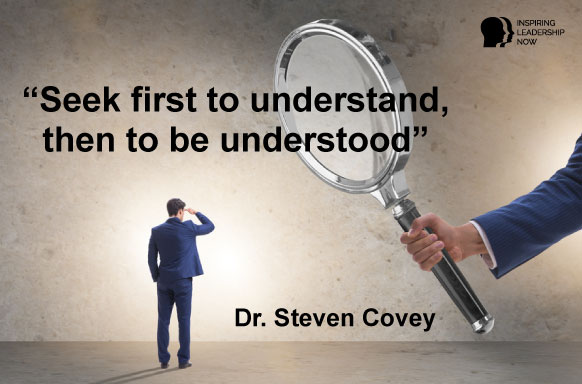Last updated: 29 September 2020

Constructive feedback doesn’t just come up at your annual performance review. Learning how to give constructive feedback is an important aspect of every relationship, in and out of work.
Giving and receiving constructive feedback that motivates and inspires is an art of leadership and a hallmark of management skills.
A natural tendency to avoid giving negative feedback, dismiss constructive criticism, or take a negative evaluation personally, stands in the way of deriving its benefits and value.
Here’s our 5-step how-to guide for leaders and managers based on Douglas Stone and Sheila Heen’s book Thanks for the Feedback to master the art of receiving and delivering constructive feedback.
Step One: Be Clear On The Outcome Of Your Constructive Feedback

Before you get busy delivering your feedback, be clear on your outcome.
Ultimately, the goal of a well-delivered constructive feedback is to support your employees to understand what success in their role looks like: for them, the team, and the company.
In addition, your team member should walk away with clarity on what they are working towards, and what your collective, desired results are.
Forms of Feedback
Feedback has three distinct forms, according to Stone and Heen: evaluation, coaching and appreciation.
- Performance review is an example of evaluation feedback – information on where you stand within your organization, and/or how you are measuring up against a set of standards.
- Coaching takes a different form, providing encouraging feedback to support self-improvement.
- Appreciation is giving praise and recognizing accomplishments. It provides motivational feedback by acknowledging and marking achievements.
All 3 forms often get combined in typical feedback conversations, yet they make up 3 distinct types of input.
Separate Feedback Forms
To deliver feedback successfully, the 3 forms of feedback are best served separately.
Be clear about which one you are initiating because when combined, they can have a negative impact says Stone and Heen.
Take for example, some negative evaluation feedback you might have received before, like the loss of a bonus.
Negative evaluations such as these can have immediate consequences (as you know if you have been in that situation!).
You may hear your boss’s attempt to coach you at that moment, like an evaluation, distorting how you understand the message.
Your emotional reaction to the information may drown out the intended message, which (s)he is offering with the intention of support.
Evaluation and coaching feedback have become intermingled in this example, with a negative outcome.
So, when you’re delivering feedback, keep the forms separate.
Stay focused and have a clear plan which you can then build together.
If you intend to discuss and evaluate performance against a set of metrics, state and communicate this clearly as your intention.
Name your outcome, which might be to get clear on what is expected from them, with an understanding of current performance levels.
Or, say it’s a coaching session: stick to coaching and leave evaluations out.
And likewise, appreciation: remember that your team-members need your appreciation, some more than others. If you fall into providing coaching instead of demonstrating or expressing appreciation, it confirms a perception that you undervalue them.
Step Two: Create A Safe Environment

For your feedback to be of most value, it should be delivered in real-time says Heidi Lynne Kurter of Forbes. It also needs to be delivered in an appropriate setting, and in an appropriate way.
Praise can be expressed in public, yet negative feedback needs to be privately shared.
A Safe Environment is a Healthy Environment
A safe environment is a healthy way of delivering feedback.
Creating a safe environment means knowing the difference between healthy and unhealthy ways of feeding back information.
An unhealthy environment (not meaning unwashed coffee cups and an overspilling trash can) is a space lacking a sense of psychological safety.
In other words, space where workers feel threatened or are not comfortably able to express themselves.
This will put them on the defensive. They will shut down or disengage, so your feedback will fall on deaf ears.
In a healthy environment, however, there is a safe atmosphere where your protégés feel safe to respond and are receptive to you and the information.
As a leader, it is your mission to create a safe, healthy space that facilitates open and respectful dialogue.
To maintain a safe space, stay calm when you are delivering feedback.
Avoid blaming or threats. And avoid “fear-provoking statements” such as “you need to…” or “you didn’t…” According to Kurter, “using the right language is vital to delivering negative feedback.”
When you have your healthy and safe environment, use the feedback scenario as an opportunity to teach, Kurter writes.
Look at areas where your team member is excelling and then ease towards a dialogue that explores where improvements could be made.
Keep information current when discussing productivity. Look at the present time and towards the future.
Conversely, revisit your colleague’s past achievements when referring to the quality of their work and find opportunities on how to give constructive feedback.
Make It Relevant
If your intention is to influence your co-worker through your feedback, make it relevant to that particular employee.
Everyone has their own goals. Understanding what these goals are and aligning your information with these specific aims is vital to constructive feedback.
Check it out, do your homework:
- Is your colleague looking for a sideways move into a different aspect of their present role?
- Are they all about CPD and building their skills to develop responsibilities and independence where they are?
- Or are they looking for a new role entirely?
All these objectives are completely different, so their particular focus needs to feature in your feedback.
If what you are telling someone isn’t in line with their own aspirations, the influence of what you are feeding back will be limited.
However, if you are delivering information that follows their objectives, your feedback will have a far greater impact and is far more likely to inspire.
So, get relevant and make it specific for it to motivate.
Step Three: Don’t Assume

There is a handy saying “never assume, because it makes an ass of u and me!”
Every individual has their own distinct way of processing and interpreting information. Don’t assume your interpretation is the same as other’s.
This assumption can lead to conflict and heightened emotions as a result of misunderstanding and misinterpretations.
Rather than assume, Kurter advises sticking to and gathering facts. Focus on the facts of the situation rather than making any criticisms based on assumptions.
Depersonalize the Situation
To lessen assumptions and lower emotional reactions, Brian Cairns, CEO of ProStategix Consulting, stresses the importance of depersonalizing the situation.
His suggested method is to document the facts before providing your feedback.
It allows you to have them as a reference if emotional levels rise, or to use as teaching examples.
Additionally, it gives you a bigger picture, so that you can factually discuss the wider impact on the team, organization or client.
Don’t Change the Conversation. Don’t Switchtrack
What you think about someone dominates your reaction to his or her feedback, more than the content of the message.
Underlying issues of trust, credibility, or a leader’s skill at giving feedback can override the message itself, leaving feedback lost in a heated or defensive, emotional conversation.
This happens in daily life and often in relationships.
For example, where a partners’ attempt to coach the other results in the other feeling underappreciated for their efforts. Yet the conversation remains at the surface and doesn’t address the real issues. This is what Stone and Heem call “switchtracking.”
Switchtracking occurs regularly in business and prevents those involved in discussing the interpersonal issues that are raised.
Constructive feedback in this scenario gets lost in an argument because neither party realizes what is actually happening. A conversation that switchtracks isn’t a lost cause if both sides are able to notice and call-out the relationship issues hiding behind it.
When you notice switchtracking, Stone and Heem suggest stepping outside the conversation to point out the differences under discussion.
By addressing them separately, talking about each one on its own terms, means that you catch the switchtrack before your conversation spins out of control.
Recognizing a switchtrack represents an opportunity because it brings up deeper issues that people couldn’t otherwise raise. It is part of how to give constructive feedback and going through the resolution process.
Step Four: Seek to Understand

On receiving negative feedback, some of your team may shut down or respond defensively.
You can prevent this from occurring by first giving your employees the chance to share how they thought they approached a situation or finished a task in the way they did, says Kurter.
Solicit their feedback and seek to understand what happened from their point of view.
Actively Listen
By listening carefully and actively to your team’s response will give you valuable insight into why a challenge or oversight ensued.
Even though you may be the one giving feedback it doesn’t mean that you must be the one to do all the talking. Glenn Liebowitz in Inc.com recommends dialing back this tendency and simply listening to what your colleague has to say. The conversation should be balanced between both parties.
A sure-fire way of demonstrating your understanding and active listening is to seek your employees’ feedback. Look to their opinions as potential solutions.
According to a study detailed in HR.com, 47% of employees said that problems in their personal lives affect their job performance.
So, take time to listen, understand, and build genuine rapport with your team. It will leave you better placed to understand the root causes behind poor performance or missed targets.
By compassionately understanding your employees’ situations you can work to build a solution that is beneficial and valuable to everyone.
Dig Deep and Find the Truth – On the Receiving End of Feedback
To really understand what is being fed back to you, you sometimes need to dig a little deeper to find the truth.
When you are the recipient of feedback, pay attention to the aspects of the feedback that convey information about you that might have been in your blind spot. Ask for clarity on those points.
Understanding feedback doesn’t mean you have to accept it. However, understanding it more clearly will illuminate your reasons for either using or rejecting it. Stone and Heen write that “Being able to say ‘no’ is not a skill that runs parallel to the skill of receiving feedback well; it’s right at the heart of it.”
To perceive feedback clearly, they advise setting the issue aside for a moment to analyze the relationship systems at play.
Typically, people view the feedback they give as constructive criticism and interpret feedback from others as being blamed.
To overcome this tendency requires taking a broader view of the roles and systems that shape human interactions.
Consider for example, how conflicting roles, organizational structures, timing, and environment shape your behavior.
This will help to remove personal judgment from feedback you receive.
Use Feedback as a Tool for Growth
Responding well to feedback requires cultivating what Stone and Heen call a “growth identity.”
A growth identity allows you to embrace your personality’s complexity, seeing your traits as being in flux, and accepting feedback as an opportunity to improve.
It means hearing the coaching hidden in feedback, learning from any negative evaluations and dismissing what the giver’s judgment might say about your personality.
Step Five: Establish A Culture of Feedback

Well delivered feedback and well-placed follow-up drives accountability and motivates positive change.
It’s a fact: A survey with the Harvard Business Review revealed that 82% of Americans say their managers don’t recognize them adequately for their efforts.
An additional study by Socialcast (VMware) reports that 69% of employees state they would work harder if their work was recognized.
These are compelling numbers. It seems that we are all about feedback, it’s a motivational, driving force of inspiration (that can be often misused or underused).
A Culture of Learning
Feedback within companies can be complicated because organizational systems of feedback are usually always imperfect.
Yet with feedback being such a valuable tool, as the statistics show, it is worthwhile investing in creating a culture of learning where feedback is central.
Stone and Heen suggest setting it up like this:
- Establish a transparent feedback system that is open to employee input
- Be sure to formally separate the three types of feedback
- Base your evaluations of others on clear, consistent criteria
- Actively engage in coaching services and expressions of appreciation year-round
- Team leaders should model feedback by soliciting it themselves; sharing stories of learning from their mistakes and emphasizing positive behaviors
- Foster a “culture of learning” in which employees actively seek ways to improve
Mastering how to give constructive feedback at work is an art of leadership and a stamp of management skill. It is a force that motivates and inspires. And with these 5 steps and top tips, it is yours.


